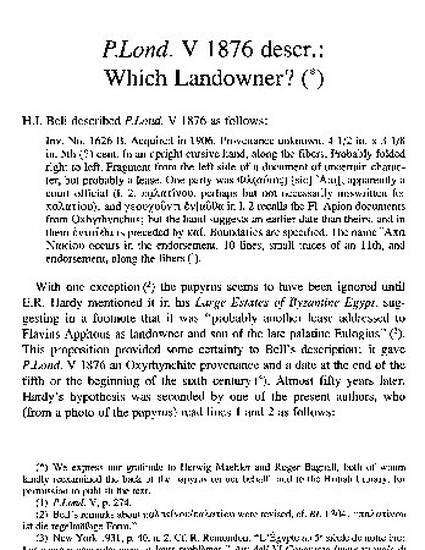
H.I. Bell described P.Lond. V 1876 as follows: Inv. No. 1626 B. Acquired in 1906. Provenance unknown. 4 1/2 in. x 3 1/8 in. 5th (?) cent. In an upright cursive hand, along the fibers. Probably folded right to left. Fragment from the left side of a document of uncertain character, but probably a lease. One party was Φλ(αύιος) [sic] Άπι[, apparently a court official (1. 2, πᾳλατίνου, perhaps but not necessarily miswritten for παλατίου); and Υεουχοὖντι ἐν[αὗθα in l. 2 recalls the Fl. Apion documents from Oxhyrhynchus; but the hand suggests an earlier date than theirs, and in them ἐνταῦθα is preceded by Kai. Boundaries are specified. The name Ἅπα Νακίου occurs in the endorsement. 10 lines, small traces of an 11th, and endorsement, along the fibers. With one exception, the papyrus seems to have been ignored until E.R. Hardy mentioned it in his Large Estates of Byzantine Egypt, suggesting in a footnote that it was "probably another lease addressed to Flavius Apphous as landowner and son of the late palatine Eulogius". This proposition provided some certainty to Bell's description; it gave P.Lond. V 1876 an Oxyrhynchite provenance and a date at the end of the fifth or the beginning of the sixth century.
© Association Égyptologique Reine Elisabeth, 2004.

Author Posting. © Association Égyptologique Reine Elisabeth, 2004. This article is posted here by permission of the Association Égyptologique Reine Elisabeth for personal use, not for redistribution. The article was published in Chronique d'Égypte 79, 2004.